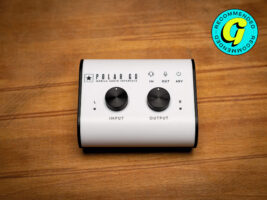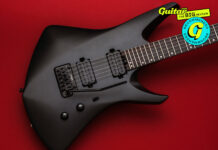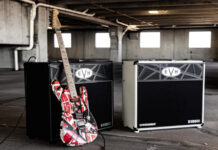
Blackstar Polar GO mobile audio interface review: “I was amazed at the sensitivity of the mics”
$129/£79, blackstaramps.com
Whether you’re preserving ideas from a writing session or recording a breakthrough EP like Steve Lacy’s Demo, a smartphone is the most immediate device most of us have for capturing sound.
But despite the improvement in phone mics over the last decade, getting something to truly sound good without some pricey external hardware in the mix has proved stubbornly elusive… at least until now.
READ MORE: EarthQuaker Devices Easy Listening review – can an amp simulator this simple actually sound good?
The Polar GO from Blackstar is the most compact iteration of its impressive Polar family of audio interfaces. But what’s really exciting about it is the combination of size, features and price it offers. This promises to be an affordable interface that will make your audio sound better… and you won’t even need a mic to do it.
Image: Press
Blackstar Polar GO – what is it?
Blackstar describes the GO as not an audio interface but a “complete, pocket-sized studio designed for the modern creator” – and while that seems like the sort of marketing hyperbole you’d normally treat with an eye-roll, when you take a closer look, you can see what the British company means.
So, yes, it’s an audio interface, but it’s one that’s absolutely tiny (it comfortably fits in the palm of your hand), complete with a rechargeable built-in battery, a combined ¼-inch/XLR input with 48V phantom power, a USB-C out for plugging into your phone/laptop and a 3.5mm headphone jack for live monitoring.
Most excitingly, however, it also comes with Blackstar’s ProCapture Stereo Mics – a pair of onboard microphones to offer quality stereo recordings to elevate what you’re doing without the need for any kind of bulky traditional mic. This is plug-in-and-play recording – but with less plugging in.
That’s further enhanced by the GO’s onboard DSP engine that applies the onboard reverb, compression, EQ and noise control (editable via the Polar GO app) to make what you’re capturing sound pro-ready before it even hits your stream or recording software. You’re able to save one setting at a time to the hardware to use independently from the app.
Effectively, in goes your vocal or instrument signal; out comes a tailored sound to record in GarageBand, BandLab or whathaveyou, or stream/upload to YouTube, TikTok or Twitch.
In addition to the simple onboard controls (input and output) you also get the Polar GO App, which supports iOS and Android (even my gracefully ageing Pixel) and allows you to tailor your sound by tweaking the EQ, compression, reverb and the like to taste. It also allows you to record video directly while you’re playing, and comes with a bunch of presets designed to enhance various input sources.
Polar GO App. Image: Press
Blackstar Polar GO – build quality
The striking thing about the Polar GO as a physical device is how compact and light it seems – even with that in-built battery that promises about four hours of recording time, it still only weighs 136g, or less than five ounces in old money.
Despite that it manages to squeeze all its various essential inputs and outputs into its case without it feeling cramped – the power and data USB-C ports are on one side along with the headphone out, while the combi XLR/jack input and buttons for power and phantom power are on the other, leaving the top clear for the input and output knobs, status LEDS and the mics themselves.
It all serves to keep the cabling and tangling of said cables to an absolute minimum. The light weight means you can easily pull it off a desk/bench/knee if you’re not careful. But it feels rugged enough, and if you’re really worried about such things, the Polar GO’s base is magnetic, so you can attach it to a mic stand or similar with any Magsafe or similar mobile phone mount.
Polar GO with XLR. Image: Press
Blackstar Polar GO – in use
While the Polar GO’s knobs, connections and mics are all impressive in themselves, what really matters is how they interact with your smartphone.
For me, an Android user, it proved incredibly simple to feed a signal from the interface to mobile apps like Fender Studio and my phone camera app’s video function, by connecting the interface to the phone via USB-C. With sound achieved with minimal fuss, it was time to open the app and play around with the settings on Blackstar’s Polar GO App.
Here you’ll find a good range of presets for different types of input, including mic’d acoustic guitar or vocals, bass guitar and external vocal mic, plus reverb (‘space’) settings with preset ‘Hall’, ‘Cave’, ‘Room’, ‘Plate’ and ‘Vocal’ parameters.
One slightly disappointing thing is that there are no bespoke electric guitar presets, which struck me as odd given Blackstar’s pedigree with digital guitar sounds. The upshot is that you’ll either want to add effects and the like to your guitar signal before it hits the GO – via an amp modeller or pedalboard, for example – or at the other end with an amp and effects plugin. This is no biggie given the ubiquity of such options nowadays, but it’s a small drawback for electric guitar players.
Image: Press
You have the option to multi-track (or simultaneously record) via the mic and line inputs, which is a big plus for singer-songwriters. For a full-band live recording, you’d need an interface with more channels, and you’d probably be recording onto a computer, anyway.
The headline item is definitely those ProCapture Stereo Mics, however – they are a huge upgrade on what you’d normally get from a smartphone mic. I was amazed at the sensitivity of the mics when monitoring with headphones. The mics captured all the fine, textural detail of acoustic playing, as well as background noises in the room.
It’s easy to see why Blackstar is pitching the GO as much to, podcasters and ASMR content creators as musicians – they’ll certainly capture all the detailed nuances of a sound. In fact, they pick up so much more than a smartphone mic, you’ll need to be mindful of movement during recording – it’s easy enough for a stray chair creak or rustle of clothing to be picked up.
One other thing to be aware of is that the Polar GO App is smartphone-only, so while you can plug the interface into a Mac or Windows laptop, its full functionality is only available to mobile users.
Polar GO with headphones. Image: Press
Should I buy the Blackstar Polar GO?
Obviously, something this portable isn’t going to offer the features and functionality of a full-size audio interface, but what’s impressive is how few compromises you actually have to make with the Polar GO.
The onboard mics are what make this a true game-changer, however; significantly reducing the amount of kit you need to take with you to be able to record excellent-sounding audio on the go. With a keen price and sensible sound-enhancing on-board features aimed at those who just want to sound good without hassle, this is one of the best smartphone audio interfaces out there.
Blackstar Polar GO – alternatives
Building microphones into the actual audio interface is a USP that sets the Polar GO apart, but there are plenty of more traditional mobile recording interfaces out there should you not need them. IK Multimedia’s iRig Pro I/O ($169.99) offers similar combi input flexibility to the GO, and even adds MIDI if you should need such a thing, while the more compact TC Helicon’s GO Guitar Pro ($79/£69) is a solid budget option.
The post Blackstar Polar GO mobile audio interface review: “I was amazed at the sensitivity of the mics” appeared first on Guitar.com | All Things Guitar.
Source: www.guitar-bass.net











